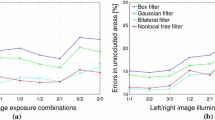Abstract
Robust stereo and optical flow disparity matching is essential for computer vision applications with varying illumination conditions. Most robust disparity matching algorithms rely on computationally expensive normalized variants of the brightness constancy assumption to compute the matching criterion. In this paper, we reinvestigate the removal of global and large area illumination artifacts, such as vignetting, camera gain, and shading reflections, by directly modifying the input images. We show that this significantly reduces violations of the brightness constancy assumption, while maintaining the information content in the images. In particular, we define metrics and perform a methodical evaluation to identify the loss of information in the images. Next we determine the reduction of brightness constancy violations. Finally, we experimentally validate that modifying the input images yields robustness against illumination artifacts for optical flow disparity matching.
Preview
Unable to display preview. Download preview PDF.
Similar content being viewed by others
References
Aujol, J.F., Gilboa, G., Chan, T., Osher, S.: Structure-texture image decomposition - modeling, algorithms, and parameter selection. Int. J. Computer Vision 67, 111–136 (2006)
Choudhury, P., Tumblin, J.: The trilateral filter for high contrast images and meshes. In: Proc. Eurographics Symp. Rendering, pp. 1–11 (2003)
.enpeda. dataset 2 (EISATS), http://www.mi.auckland.ac.nz/EISATS
Haralick, R.M., Bosley, R.: Texture features for image classification. In: Proc. ERTS Symposium. NASA, vol. SP-351, pp. 1219–1228 (1973)
Haussecker, H., Fleet, D.J.: Estimating optical flow with physical models of brightness variation. IEEE Trans. Pattern Analysis Machine Intelligence 23, 661–673 (2001)
Hirschmüller, H., Scharstein, D.: Evaluation of stereo matching costs on images with radiometric differences. IEEE Trans. Pattern Analysis Machine Intelligence (to appear)
Kuan, D.T., Sawchuk, A.A., Strand, T.C., Chavel, P.: Adaptive noise smoothing filter for images with signal-dependent noise. IEEE Trans. Pattern Analysis Machine Intelligence 7, 165–177 (1985)
Lee, J.-S.: Digital image smoothing and the sigma filter. Computer Vision, Graphics, and Image Processing 24, 255–269 (1983)
Mileva, Y., Bruhn, A., Weickert, J.: Illumination-robust variational optical flow with photometric invariants. In: Hamprecht, F.A., Schnörr, C., Jähne, B. (eds.) DAGM 2007. LNCS, vol. 4713, pp. 152–162. Springer, Heidelberg (2007)
Middlebury dataset, http://vision.middlebury.edu/stereo/data/
Morales, S., Woo, Y.W., Klette, R., Vaudrey, T.: A study on stereo and motion data accuracy for a moving platform. Technical report, MI-tech-32. University of Auckland (2009), http://www.mi.auckland.ac.nz/
Rudin, L., Osher, S., Fatemi, E.: Nonlinear total variation based noise removal algorithms. Physica D 60, 259–268 (1992)
Scharstein, D., Pal, C.: Learning conditional random fields for stereo. In: Proc. IEEE Conf. Computer Vision and Pattern Recognition (2007)
Tomasi, C., Manduchi, R.: Bilateral filtering for gray and color images. In: Proc. IEEE Int. Conf. Computer Vision, pp. 839–846 (1998)
Vaudrey, T., Klette, R.: Residual images remove illumination artifacts. In: Proc. Pattern Recognition - DAGM (to appear, 2009)
Vaudrey, T., Rabe, C., Klette, R., Milburn, J.: Differences between stereo and motion behaviour on synthetic and real-world stereo sequences. In: Proc. IEEE Image and Vision Conf., New Zealand (2008); Digital Object Identifier 10.1109/IVCNZ.2008.4762133
Wedel, A., Pock, T., Zach, C., Bischof, H., Cremers, D.: An improved algorithm for TV-L1 optical flow. Post Proc. Dagstuhl Motion Workshop (to appear, 2009)
van de Weijer, J., Gevers, T.: Robust optical flow from photometric invariants. In: Proc. Int. Conf. on Image Processing, pp. 1835–1838 (2004)
Zach, C., Pock, T., Bischof, H.: A duality based approach for realtime TV-L1 optical flow. In: Hamprecht, F.A., Schnörr, C., Jähne, B. (eds.) DAGM 2007. LNCS, vol. 4713, pp. 214–223. Springer, Heidelberg (2007)
Author information
Authors and Affiliations
Editor information
Editors and Affiliations
Rights and permissions
Copyright information
© 2009 Springer-Verlag Berlin Heidelberg
About this paper
Cite this paper
Vaudrey, T., Wedel, A., Klette, R. (2009). A Methodology for Evaluating Illumination Artifact Removal for Corresponding Images. In: Jiang, X., Petkov, N. (eds) Computer Analysis of Images and Patterns. CAIP 2009. Lecture Notes in Computer Science, vol 5702. Springer, Berlin, Heidelberg. https://doi.org/10.1007/978-3-642-03767-2_135
Download citation
DOI: https://doi.org/10.1007/978-3-642-03767-2_135
Publisher Name: Springer, Berlin, Heidelberg
Print ISBN: 978-3-642-03766-5
Online ISBN: 978-3-642-03767-2
eBook Packages: Computer ScienceComputer Science (R0)




